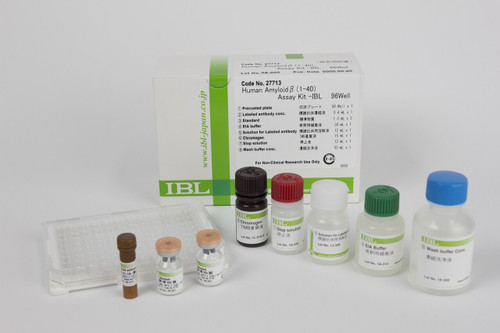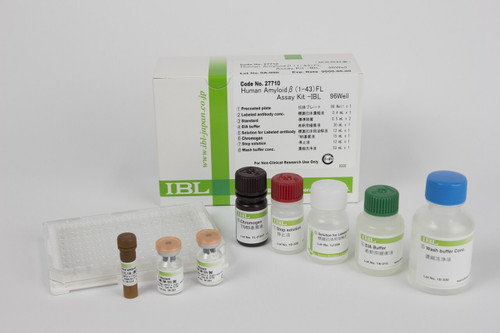Solid phase sandwich ELISA for the determination of human Aβ ( 1-40 ) ( FL ) in EDTA-plasma, cerebrospinal fluids, serum, cell culture media or the extract from brain tissue. For research use only, not for use in diagnostic procedures.
The first case of Alzheimer's disease (AD) was defined and reported in 1907 by the German scientist, Dr. A. Alzheimer. His studies have shown that this is the main cause of dementia in the elderly.
The plaques which appear in the brains of individuals who suffers AD patients are mostly constituted by the Amyloidβ (Amyloid Beta) protein. Amyloid Beta is a peptide which consists of 40 or 42 (43) amino acids, and reports show that this is cleaved from β- and γ- secretase from the amyloid precursor protein. APP is a trans-membrane protein consisting of 695, 751, or 770 amino acids. Reports have shown many variants of Amyloid Beta exist and are clarified into the culture supernatant from the APP cDNA transfected mouse neuroblastoma cell.
Furthermore, in 1995, a dominant and differential deposition of distinct βamyloid peptide species, Amyloid Beta (N3pE), in senile plaques was found by Saido et al. This modified molecule, starting at the 3rd amino terminal residue, glutamate, was discovered to convert to pyroglutamate through intramolecular dehydration.
This kit uses a monoclonal antibody as labeled antibody which was developed to react with N-terminal of Amyloid Beta specifically and not to react with APP. So this kit can measure only full-length Amyloid Beta of which N-terminal side is not cleaved (“FL” means full-length)
And further, the sensitivity and specificity of this kit is improved, compared to IBL Code No. 27714 Human Amyloid Beta (1-40) (N) Assay Kit. IBL has many other kinds of Amyloid Beta related products for AD research. They are very specific assay systems for each target and they can be used according to the purpose of study.
Furthermore, in 1995, a dominant and differential deposition of distinct βamyloid peptide species, Amyloid Beta (N3pE), in senile plaques was found by Saido et al. This modified molecule, starting at the 3rd amino terminal residue, glutamate, was discovered to convert to pyroglutamate through intramolecular dehydration.
This kit uses a monoclonal antibody as labeled antibody which was developed to react with N-terminal of Amyloid Beta specifically and not to react with APP. So this kit can measure only full-length Amyloid Beta of which N-terminal side is not cleaved (“FL” means full-length)
And further, the sensitivity and specificity of this kit is improved, compared to IBL Code No. 27714 Human Amyloid Beta (1-40) (N) Assay Kit. IBL has many other kinds of Amyloid Beta related products for AD research. They are very specific assay systems for each target and they can be used according to the purpose of study.
- Assay Description:
- Overnight incubation (4°C) + 1 hour (4°C) + 30 (RT) = Overnight + 1 hour, 30 min. total incubation time
- Catalog number:
- 27718
- configuration:
- 96 Determinations, 12x8 removable strips
- controls:
- None provided
- design:
- Solid phase sandwich ELISA using 2 kinds of high specific antibodies
- FDA Status:
- For research use only, not for use in diagnostic procedures
- MSDS:
- notes:
- The protocol for this product (see above) is intended to serve as an example only. Please refer to the Instructions For Use provided with the assay kit for precise details.
- Other names:
- Aβ, Amyloid beta, A-beta
- Protocol:
- Sample types:
- EDTA-plasma, cerebrospinal fluids, serum, cell culture media, extract from brain tissue
- Sample volume:
- 100 μL of properly diluted unknown / determination
- standards:
- 8 standards, serially diluted from 1 prepared lyophilized standard
- Standard range:
- 0 / 1.56 - 100 pg/mL
- storage:
- 2 - 8 °C
- sensitivity:
- 1.01 pg/mL
- Species:
- Human
- Products related:
- The control set is available for sale on request.
- Additional info:
- References:







